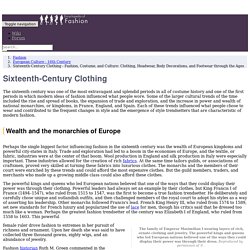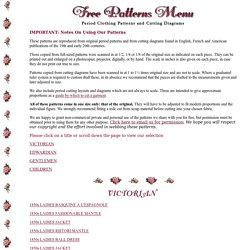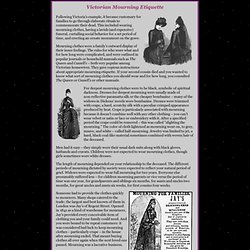

A blog about recreating period clothes. Anglorum - Saxon Social Organisation. Mistress Safia's Middle Eastern Garb patterns. Dar Anahita: Rashid's Patterns. Pirihan is the basic "undershirt" worn by men and women. Women's are long -- mid-calf to ankle length. Men's can be short -- knee to mid-thigh length, but it is probable that in a formal situation a man wore long pirihan. Salwar are the pants worn by men and women. I am not certain of the Persian, but in Turkish this is pronounced "shal-var". Salwar are wide at the top with the legs tapering to narrow ankles. Salwar - based on 16th c. Yourwardrobeunlockd. Dolores Monet. OLD TIME PATTERNS - Period correct, historical sewing patterns f. Back To The Dark Ages. Medieval armor, medieval costume and renaissance costume, medieval boots and shoes, medieval tents.
Clothing, Costuming and Textiles - Ravensgard. Eneral Costuming mbroidery, Textiles and Dyes arp-Weighted Loom ablet Weaving ewelry Making eneral Supplies Return to <A HREF="medieval.html" target="_top">Main Medieval Page</A>, <A HREF="interests.html" target="_top">Medieval Arts and Sciences Page</A>, or <A HREF="..

Dark Ages Clothing : Historic Enterprises, We're making history. A 9th Century Viking Caftan. As I've mentioned earlier, my daughter has recently decided that she would like to wear Viking Era clothing. In putting together her wardrobe, I decided that she should have a warm, outer layer for winter. Some quick research led me to the caftan. In nova corpora. In nova corpora. Outfit einer Magd aus Köln, 1586 Ich mag Jost Ammans Holzschnitte der Trachten in Konrad Lautenbachs (alias Thrasibulus Torrentinus Mutislariensis), Im Frauwenzimmer Wirt vermeldt von allerley schönen Kleidungen vnnd Trachten der Weiber..., Frankfurt a.M. 1586, sehr gerne (hier der Link zu Wikisource). Schon lange habe ich daran herumstudiert, die Basler Dame oder die Jungfrau aus Zürich nachzunähen. Das Rennen hat am Ende aber die Magd aus Köln gemacht. Das Ganze soll ja auch praktisch sein und schmutzig werden dürfen.
Geplant war das Ganze folgendermassen: Ich habe mich ausnahmsweise mal recht eng an den Plan gehalten. Das Unterhemd, das Kleid, die Ärmel, der Weiberspeck und die Krägen sind ganz handgearbeitet (genäht und versäubert), beim Unterkleid sind die Innennähte mit der Maschine gemacht (das wird bei Gelegenheit aber mal geändert werden), die Schnürbrust ist ganz maschinengenäht. Historical Costumes Gallery. Sew - mill. 3658. Figure 1: gown based on Moy gown, front Background This garment, presumed to be a woman’s, was discovered in a bog in Moy, County Clare, Ireland in 1931. The age of the gown is not known, but it is presumed to be from the mid 14th century to late 15th century based on its construction. There are at least two very detailed accounts of this garment available. Tudor Clothes. Sixteenth-Century Clothing - Fashion, Costume, and Culture: Clot. The sixteenth century was one of the most extravagant and splendid periods in all of costume history and one of the first periods in which modern ideas of fashion influenced what people wore.

Some of the larger cultural trends of the time included the rise and spread of books, the expansion of trade and exploration, and the increase in power and wealth of national monarchies, or kingdoms, in France, England, and Spain. Each of these trends influenced what people chose to wear and contributed to the frequent changes in style and the emergence of style trendsetters that are characteristic of modern fashion.
Wealth and the monarchies of Europe Perhaps the single biggest factor influencing fashion in the sixteenth century was the wealth of European kingdoms and powerful city-states in Italy. Recreating 16th and 17th Century Clothing: The Renaissance Tailo. Demonstrations>Accessories:Western European>Flat Caps and Tall Hats Once upon a time, a really long time ago, I joined a historical re-enactment society.

I constructed a huge number of really bad hats back then but I loved hats so I kept at it. Then, one day, while I was wearing one of my latest tall hat creations (something closer to accurate but still not quite there), a well-meaning but rather tactless long time player bluntly informed me that my hat was so incredibly incorrect that he could not contain himself and had to say something. In public. Learning Zone Broadband Class Clips - Tudors - Children cl.
A Gable Hood. Ribbonwork by a Tudor Window, Kentwell 1578. CenturiesSewing's deviantART Gallery. Sewing Central, Historic Patterns and Fabrics. House Morningstar Surcoats. Italian Renaissance. Elizabethan. Elizabethan Costuming Page. Www.sempstress.org. Society for Creative Anachronism, Inc. How-To Articles. Costume Patterns. Extreme Costuming. Raised_Stitches. Free Patterns Menu: Period Clothing Patterns and Cutting Diagram. Period Clothing Patterns and Cutting Diagrams IMPORTANT: Notes On Using Our Patterns These patterns are reproduced from original period patterns and from cutting diagrams found in English, French and American publications of the 19th and early 20th centuries.

Those copied from full-sized patterns were scanned in at 1/2, 1/4 or 1/8 of the original size as indicated on each piece. They can be printed out and enlarged on a photocopier, projector, digitally, or by hand. The scale in inches is also given on each piece, in case they do not print out true to size. Patterns copied from cutting diagrams have been scanned in at 1 to 1½ times original size and are not to scale. We also include period cutting layouts and diagrams which are not always to scale. All of these patterns come in one size only: that of the original. Please click on a title or scroll down the page to view our selection.
1800s. 18th century. Edwardian costume. Historical Dress Patterns, Historical Costume Patterns, Historic. Past Patterns. We Make History: Where History & The Arts Meet! The Gentleman's Page. Victorian mourning etiquette. Following Victoria’s example, it became customary for families to go through elaborate rituals to commemorate their dead.

This included wearing mourning clothes, having a lavish (and expensive) funeral, curtailing social behavior for a set period of time, and erecting an ornate monument on the grave. Mourning clothes were a family’s outward display of their inner feelings. The rules for who wore what and for how long were complicated, and were outlined in popular journals or household manuals such as The Queen and Cassell’s – both very popular among Victorian housewives. They gave copious instructions about appropriate mourning etiquette. If your second cousin died and you wanted to know what sort of mourning clothes you should wear and for how long, you consulted The Queen or Cassell’s or other manuals. For deepest mourning clothes were to be black, symbolic of spiritual darkness. Men had it easy – they simply wore their usual dark suits along with black gloves, hatbands and cravats.
Introducing Victorian etiquette and Victoriana lifestyles in the.